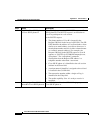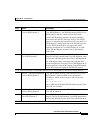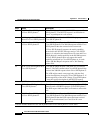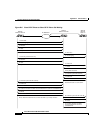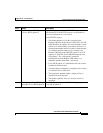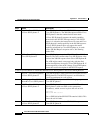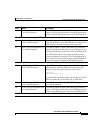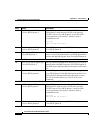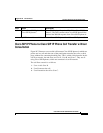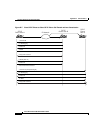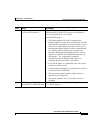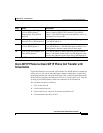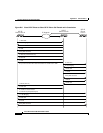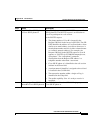
Appendix B SIP Call Flows
Call Flow Scenarios for Successful Calls
B-30
Cisco SIP IP Phone 7960 Administrator Guide
78-10497-02
15
INVITE—Cisco SIP IP phone B
to Cisco SIP IP phone A
Cisco SIP IP phone B sends a mid-call INVITE to Cisco
SIP IP phone A with the same call ID as the previous
INVITE (sent to Cisco SIP IP phone A) and new SDP
session parameters (IP address), which are used to
reestablish the call.
Call_ID=1
SDP: c=IN IP4 181.23.250.2
16
200 OK—Cisco SIP IP phone A
to Cisco SIP IP phone B
Cisco SIP IP phone A sends a SIP 200 OK response to
Cisco SIP IP phone B.
17
ACK—Cisco SIP IP phone B to
Cisco SIP IP phone A
Cisco SIP IP phone B sends a SIP ACK to Cisco SIP IP
phone A. The ACK confirms that Cisco SIP IP phone B has
received the 200 OK response from Cisco SIP IP phone A.
A two-way RTP channel is reestablished between Cisco SIP IP phone A and Cisco SIP IP phone B.
18
BYE—Cisco SIP IP phone B to
Cisco SIP IP phone A
The call continues and then User B hangs up. Cisco SIP IP
phone B sends a SIP BYE request to Cisco SIP IP phone A.
The BYE request indicates that User B wants to release the
call.
19
200 OK—Cisco SIP IP phone A
to Cisco SIP IP phone B
Cisco SIP IP phone A sends a SIP 200 OK message to
Cisco SIP IP phone B. The 200 OK response notifies Cisco
SIP IP phone B that the BYE request has been received.
The call session between User A and User B is now
terminated.
The RTP channel between Cisco SIP IP phone A and Cisco SIP IP phone B is torn down.
14
INVITE—Cisco SIP IP phone B
to Cisco SIP IP phone C
Cisco SIP IP phone B sends a mid-call INVITE to Cisco
SIP IP phone C with the same call ID as the previous
INVITE (sent to Cisco SIP IP phone C) and new SDP
session parameters (IP address), which are used to
reestablish the call.
Call_ID=2
SDP: c=IN IP4 181.23.250.2
15
200 OK—Cisco SIP IP phone C
to Cisco SIP IP phone B
Cisco SIP IP phone C sends a SIP 200 OK response to
Cisco SIP IP phone B.
Step Action Description



